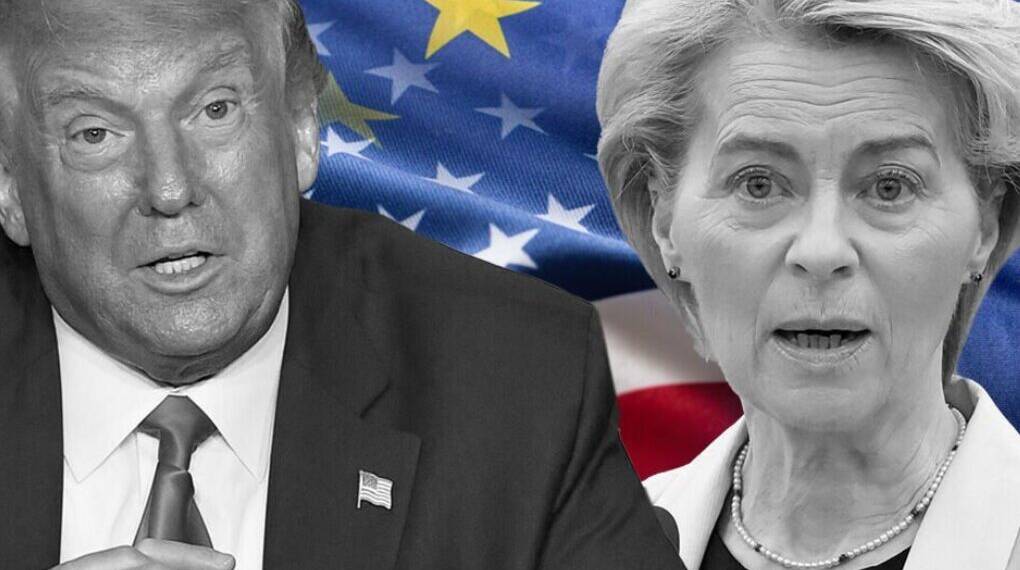In the summer of 2025, the relationship between the United States and the European Union has entered one of its most turbulent phases in decades. President Donald J. Trump, in his second term, has launched a series of aggressive policies that European leaders describe as “three deadly strikes” against the EU. Spanning trade, security, and energy, these measures are not only reshaping transatlantic relations but also raising questions about the long-term stability of the Western alliance.
Strike One: The One-Sided U.S.-EU Trade Deal
The first blow came in late July 2025 when Trump unveiled what he described as “the biggest deal ever made” — a new trade agreement between Washington and Brussels. Yet, beneath the celebratory rhetoric, the deal tilted sharply in America’s favor.
The agreement imposed a 15% tariff on most European imports, covering crucial sectors like automobiles, pharmaceuticals, and semiconductors. Meanwhile, the EU committed to purchasing $750 billion worth of U.S. energy and investing $600 billion into American infrastructure and industries.
For many in Europe, this was less a partnership and more a capitulation. EU exporters now face billions in potential losses, while European consumers must shoulder higher energy costs as the continent pivots toward American liquefied natural gas. The deal effectively ties Europe’s economy more tightly to U.S. industries, while Trump positions himself as the defender of American workers.
European lawmakers were scathing in their criticism. One member of the European Parliament called it “a capitulation disguised as partnership.” On social media, many Europeans labeled it an economic hostage contract. Trump, however, has signaled he may push even harder, threatening further tariffs if Brussels continues its multibillion-dollar antitrust fines against U.S. tech giants.
Strike Two: U.S. Withdrawal of NATO Funding for Eastern Europe
The second strike cut deeper into the continent’s security framework. In early September 2025, the Trump administration announced it would phase out hundreds of millions of dollars in security assistance for NATO allies along Russia’s border — including Poland, the Baltic states, and Romania.
For years, this funding supported training programs, military equipment, and joint exercises designed to deter Russian aggression. Its withdrawal is a major blow to Eastern European security, particularly at a time when tensions with Moscow remain high.
Trump’s reasoning was consistent with his long-standing criticism of NATO: that European nations are “not paying their fair share.” But critics argue this decision leaves a dangerous vacuum. Lithuania’s government has already warned that the move increases vulnerability along NATO’s eastern flank.
Analysts fear it could embolden Russia, while simultaneously straining the alliance by forcing wealthier Western European countries to cover the shortfall.
Trump has even suggested that U.S. troops could be withdrawn from Europe altogether if NATO allies fail to meet defense spending targets — a scenario that would fundamentally alter the balance of deterrence in Europe.
Strike Three: Forcing the EU to Cut Russian Energy Ties and Target India, China
The third strike, announced in September 2025, revolves around energy — and it may be the most disruptive of all.
During a call with Ukrainian President Volodymyr Zelenskyy and European leaders, Trump demanded that the EU immediately end all purchases of Russian oil, arguing that these revenues continue to fuel Moscow’s war machine. He highlighted that Russia earned more than €1.1 billion ($1.28 billion) from EU fuel sales in a single month.
But Trump’s demands go further. He has urged Brussels to join Washington in sanctioning other nations that buy Russian oil — especially India and China. The U.S. has already imposed 50% tariffs on Indian goods for continuing trade with Russia, while largely sparing China from similar treatment.
For Europe, this is a political and economic nightmare. The EU has already committed to phasing out Russian energy by 2028, but Trump’s accelerated timeline could send energy prices soaring. Worse still, sanctioning India and China — two of Europe’s largest trading partners — risks sparking a broader trade war.
European Energy Commissioner Kadri Simson acknowledged U.S. pressure but reiterated the EU’s existing phase-out plan. Still, Washington’s threat to unwind the new trade deal if Brussels refuses to comply leaves European leaders with little room to maneuver.
The Broader Impact: A Fractured Alliance?
Taken together, these three strikes mark a profound shift in U.S.-EU relations.
The trade deal binds Europe’s economy more tightly to American industries.
The NATO funding cuts weaken Eastern Europe’s security and embolden Russia.
The energy ultimatum risks pushing the EU into conflict with its own key partners, India and China.
Supporters of Trump’s policies argue that he is correcting long-standing imbalances: forcing Europe to contribute more to its defense, reducing reliance on Russian energy, and leveling the trade playing field.
But critics warn of a fractured alliance. By undermining NATO unity, imposing economic stress on European industries, and dragging the EU into potential trade wars, these strikes could weaken the very Western order that has defined global politics for decades.
As of September 2025, European leaders are scrambling to respond. Calls for greater strategic autonomy — in defense, trade, and energy — are growing louder in Brussels and national capitals. Yet the reality is stark: Europe still depends heavily on American markets, military support, and political backing.
Trump’s three deadly strikes may deliver short-term wins for Washington, but the long-term consequences could reshape Europe’s role in the world — and redefine the future of the transatlantic alliance.








